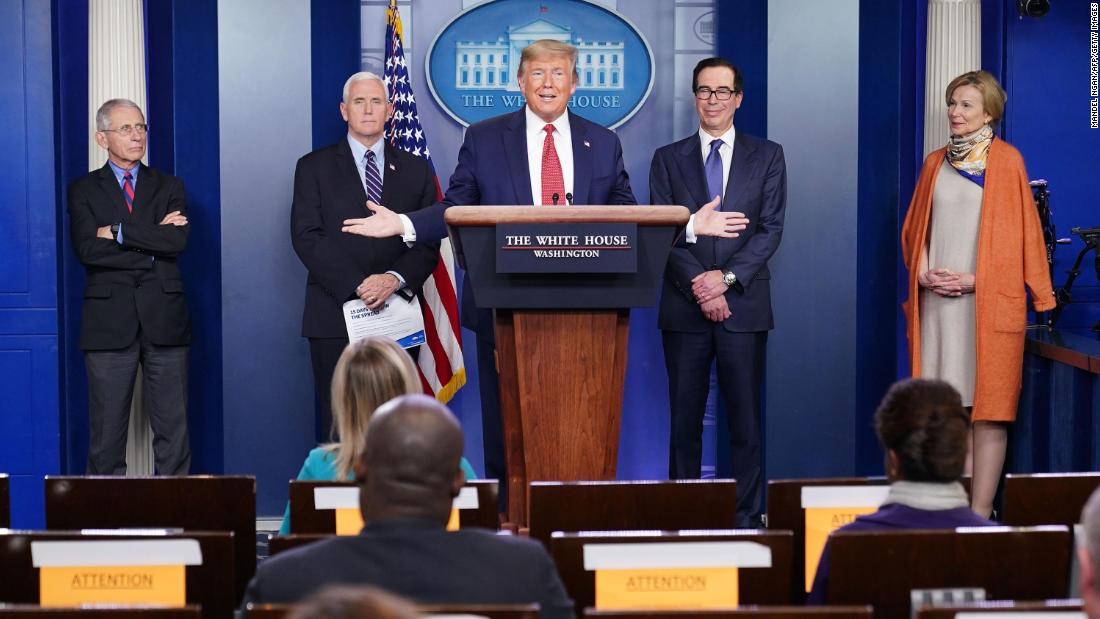[ad_1]
Disbanding the task force would also raise questions about the administration’s priorities in effectively declaring victory over a pandemic that appears likely to rage for many more months.
Trump all but admitted that he was reconciled to the deaths that epidemiologists say would result from a premature effort to open the economy.
“We have to get our country back. You know, people are dying the other way too. When you look at what’s happened with drugs, it goes up. When you look at suicides, I mean, take a look at what’s going on. People are losing their jobs — we have to bring it back, and that’s what we’re doing.”
But even talk of devaluing the importance of the task force reflects the impulses of a President who seems just to have become impatient with the grim reality of the worst domestic crisis since World War II — especially since his ratings-hit briefings were paused.
No one doubts the cataclysmic impact of the stay-at-home orders on the economy — or the need to somehow find a way to resume daily life, even in some reduced form. And it is to be hoped that a flurry of openings in a majority of states do not bring the spike in infections and deaths that experts fear.
The need to offer relief to 30 million Americans who’ve lost jobs as the economy was shut down could not be more urgent.
“So we are looking at probably the worst unemployment rate since the Great Depression,” he told Poppy Harlow.
Dangers of a botched opening
Given such circumstances, the nation faces deprivation of historic proportions that must necessarily trigger a national debate about whether shutdowns can be maintained at such cost.
But Trump’s White House is showing signs of moving toward the opening in exactly the same slapdash, politically polarizing manner that it used in the early months of the year, when the President was in denial about the problem.
A botched opening could plunge the country into even deeper economic turmoil and offer the virus a new foothold for deadlier waves of infection later in the year in the absence of a vaccine and so far proven therapies.
The administration effort has been massively criticized. That is despite Trump’s claim that the response has been hugely successful and his victory laps over an entry ban on foreign nationals who had recently been in China and his claim to have averted a feared ventilator shortage.
But signs that it is now downgrading its efforts to combat the virus dismayed the Democratic governor of one of the hardest-hit states, Ned Lamont of Connecticut.
“It doesn’t make any sense to me. I think we need more federal direction.”
Lamont’s comments reflected that the Trump administration’s pivot, while it may make sense on short-term economic grounds, appears to ignore the brutal reality of the evolution of the pandemic.
Dr. Leana Wen, a former Baltimore city health commissioner, told Blitzer that the thought of winding down the coronavirus task force was “mind-blowing.”
“We are seeing cases of a number of infections going in exactly the wrong direction. They’re increasing, and we don’t have the capabilities we need, the testing, the tracing, all these efforts that require a national coordinated presence,” Wen said.
“We don’t have that in place. And the last thing we want is to give the American people the idea that we have the virus under control, when actually nothing about the virus has changed.”
Trump in new power grab to thwart oversight
Trump’s revival rhetoric is being matched by an increasingly aggressive White House effort to cover up for the erratic federal response to the pandemic and the President’s own mistakes early in the crisis, and to thwart oversight pushes by Democrats to expose the administration’s failures.
Echoing his stand during the impeachment saga, the President on Tuesday effectively made a new power grab, making clear he will accept only oversight run by friendly Senate Republicans, flouting Congress’s traditional role.
“The House is a bunch of Trump-haters,” the President said, blasting constitutionally mandated oversight as a “setup.”
There is plenty for Congress to probe. It includes the administration’s failure to set up a comprehensive testing and tracing operation to quell coronavirus hot spots. Trump’s own misinformation, claims that the coronavirus was not a threat and his obsequious treatment of Xi will also interest investigators. And the role of Trump’s son-in-law, Jared Kushner, and his shadowy efforts to run pandemic operations will attract Democratic scrutiny.
[ad_2]
Source link


